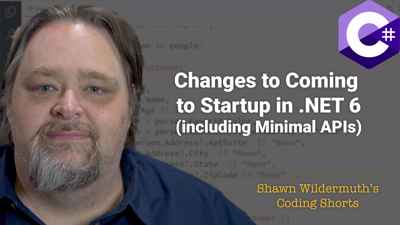My Rants and Raves

.NET 6 Preview 6 is here. One of the big changes I'm looking forward to is how startup is changing. With this change, comes "Minimal APIs" too. While getting rid of the Startup class is a welcome change, I'm a little less excited about how Minimal APIs might be over-used.

Running a build for your Vue is a common task for many Vue developers. The team behind Vue has been working on a development server to simplify this. This project is called Vite.

Like most of you, I've been using Dependency Injection in my projects for quite a while. Whether it be the built-in .NET Core Dependency Injection layer, Ninject, StructureMap, Unity, MEF, etc. I've been using a DI layer to do this work for many years. But before I understood the benefit, I did so somewhat reluctantly.

I've been working on websites for a long time now. That means that I've been writing client-side JavaScript since the early days. As the ECMAScript standards have come out, I've found it difficult to keep up with every new feature that might help me write better JavaScript.

If you've not noticed, I've been doing more video these days. I'm doing a weekly show called "Coding Shorts" where I cover topics that aren't course lengthed. The newest entry in this series is a demo of why I like Vue's Composition API. I convert an Options API to a Composition API and show you why I'm moving most of my Vue work to it.

I've got a new video that I released a couple of weeks ago. I wanted to share this out. It's about how structural typing works in TypeScript. Typing in TypeScript is a different animal than C# (or most typed languages) so I want to introduce it in one of my "Coding Shorts". I hope you like it:

NOTE: This post is going to talk about potentially triggering information and is not technical. You've been warned.

I have a new episode of my "Coding Shorts" series on YouTube. In this episode, I dig into something a little more esoteric: Bitwise operators. I show how binary math works and how it relates to enumerations (with Flags).

Our first release date for Hello World outside of the US and Canada is now here. For the countries shown below, you can watch the film via iTunes. The film has subtitles available for French, Dutch, Spanish (Latin American), and Portuguese (Brazilian).

I've started a new video series of short coding tutorials. The goal is to teach lesser-used techniques and they are less than 15 minutes each. I've got the first three up for viewing.

I was talking with one of my clients and they wondered how they could build individual components in Angular dynamically (or based on data/metadata). I knew this was possible but I hadn't done this myself so I thought I'd try to dig into it.

Over three years ago I launched a new option for learning at my company's website (https://courses.wilderminds.com). I was really excited to be able to create courses that weren't the mold of my Pluralsight courses. I wanted to be able to experiment with different ways of teaching people how to code.

If you've seen my projects or courses over the last few years, I had been advocating for using NPM for client-side libraries and SPAs at the same time. This caused the need to merge generated packages.json files. This added to the complexity. In addition, to handle the client-side libraries with NPM, you needed a way to both read the node_modules folder during development. This was handled with some middle-ware created by the late, great @OdeToCode (K. Scott Allen).

I'll try and keep this quick. I'm updating one of my Pluralsight courses and I am curious if what I'm thinking makes any sense.

This is going to be a relatively short post. I've been working with a company on merging their ASP.NET WebForms project with their MVC project. It's been an experience.

Running a build for your Vue is a common task for many Vue developers. The team behind Vue has been working on a development server to simplify this. This project is called Vite.

It's been a long time coming! I've worked on this film for the last five years and I'm very happy to announce that it's finally available!

I have a handful of web projects that I maintain. Some of these are sites like the one for my films (Hello World Film and Don't Worry, I'm Fine) but some others are community projects like Atlanta Code Camp. I've battled with the best way to develop and deploy these projects for quite a while.

I am fully aware at how this post may come across. I am a white male. A cis white male. A straight, cis, white male software developer. I am aware that talking about diversity and inclusion may come across as 'white savior syndrome' or at least tone deaf. Let's hope I can do better.

I have a couple of public projects (this blog, and the code camp website) that both use Azure Blob storage to store images for the sites. I've felt guilty that I've copy/pasted the code between them for a while. I decided to fix it.

It was a Sunday afternoon and I wanted to play with some of the new features of .NET 5 and learn something. I had a small irritation with bit.ly. When I customized a short-URL, I could never go back and update the link. That was enough for me to want to make something.

I've talked about how the term SPA annoys me. I think that client-side frameworks are great for expanding websites, not replacing them. With that in mind, I like the idea of a handful of client-side apps enhancing websites, but not every framework makes that easy.

I hope you're watching the .NET Conf happening this week. If you have, you know that .NET 5 was finally released. This version isn't a long-term support (LTS) version, but that doesn't mean that many people will be using it in production...at least I will be.

So many of the Vue demos I've seen fail to look at the authentication use case. For some of my course demos I've had to dig into it.